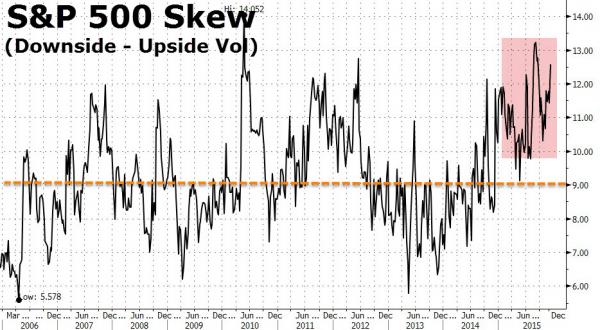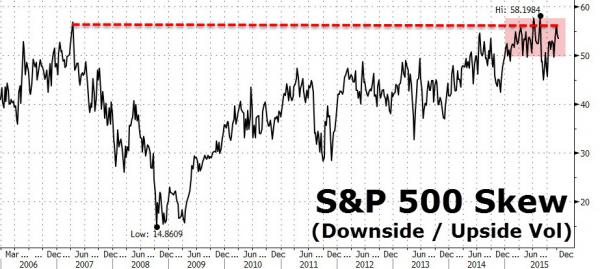At the peak of the craziness of the last cycle, banks took to protecting themselves by buying (credit) protection on other banks as a ‘hedge’ for systemic risk (which instead exacerbated contagion concerns,seemingly missing the facts that their bids drove risk wider, increaing counterparty risks, and that the inevitable collapse required to trigger these trades would also mean the payoffs to the ‘hedges’ would never be realized). Fast forward 8 years and it appears once again, as Bloomberg reports, that banks are buying (equity) protection in order to hedge the stress-test downside scenarios enforced by The Fed.
For more than a year, dealers in the U.S. equity derivatives market have noted a widening gap in the price of certain options. (chart below shows the absolute premium for downside protection over upside protection)

If you want to buy a put to protect against losses in the Standard & Poor’s 500 Index, often you’ll pay twice as much as you would for a bullish call betting on gains. (chart below shows therelative premium for downside protection over upside protection)

New research suggests the divergence is a consequence of financial institutions hoarding insurance against declines in stocks. as Bloomberg reports,
While various explanations exist including simply nervousness following a six-year bull market, Deutsche Bank AG says in a Dec. 6 research report that the likeliest explanation may be that demand is being created for downside protection among banks that are subject to stress test evaluations by federal regulators. In short, financial institutions are either hoarding puts or leaving places for them in their models should markets turn turbulent.
“Since so many banking institutions are facing these stress tests, the types of protection that help banks do well in these scenarios obtain extra value,” said Rocky Fishman, an equity derivatives strategist at Deutsche Bank.
“The way the marketplace has compensated for that is by driving up S&P skew.”













Leave A Comment